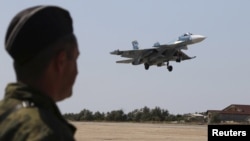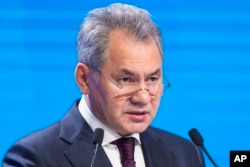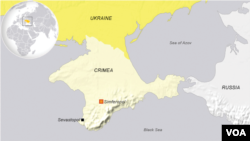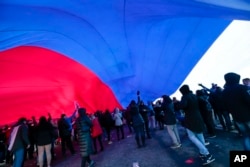The U.S. State Department expressed concern Wednesday about new troop buildups that Russia has announced that it says are meant to counterbalance an increased military presence near its borders.
“If true, we believe this would appear to run contrary to ongoing efforts to stop violence and to de-escalate the tensions in eastern Ukraine in line with Russia’s commitments [under the 2014-15 Minsk agreements],” State Department spokesman John Kirby told reporters.
The remark came hours after Russia’s defense minister, Sergei Shoigu, told a meeting at the defense ministry in Moscow that Russia has strengthened its southwestern flank, including deployment of more air defense systems there, and placed a “self-sufficient” contingent of troops in disputed Crimea.
“The main implications are for Ukraine, rather than the Baltic states, said Jeffrey Mankoff, deputy director of the Russia and Eurasia Program at the Center for Strategic and International Studies in Washington.
“I wouldn’t make too big a deal out of this decision,” Mankoff told VOA, noting that Russia has rotated forces into the southwest for a long time and has hinted at "launching a full-scale invasion of Ukraine on different occasions.”
Crimean peninsula
Concerning the new contingent on the Crimean peninsula, Kirby, in response to a VOA query, reiterated that “we’re not going to allow the borders of Europe to be withdrawn under the barrel of a gun.”
The Crimean peninsula was seized from Ukraine and annexed by Russia in 2014.
Shoigu also said in the Moscow meeting, which was aired on state television, that since 2013 Russia has formed four divisions, nine brigades and 22 regiments that include “two missile brigades armed with Iskander missile complexes,” giving a boost in “firepower to destroy the potential adversary.”
This, Shoigu explained, was in response to NATO’s build-up in Poland, the Baltic states and elsewhere near Russia’s borders.
“Neither the U.S. or NATO is a threat to Russia,” Kirby rebutted, saying the alliance’s forces are for defensive purposes only.
Some Western defense analysts have asserted that NATO needs an even more robust presence with larger and more permanent units on the alliance’s eastern flank for deterrence.
The issue has entered U.S. presidential politics, with Republican nominee Donald Trump questioning whether the United States would automatically come to the aid of other NATO allies, especially Estonia, Latvia and Lithuania — NATO members since 2004 — if they were attacked.
The candidate, with an “America First” campaign theme, says other countries need to pay a larger share of the alliance’s defense expenses.
At a 2014 NATO summit, member states — at Germany’s behest — pledged to invest at least 2 percent of their gross domestic product for defense by 2024.










